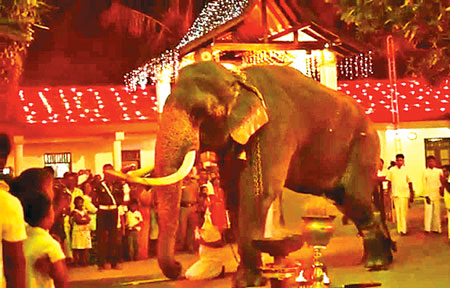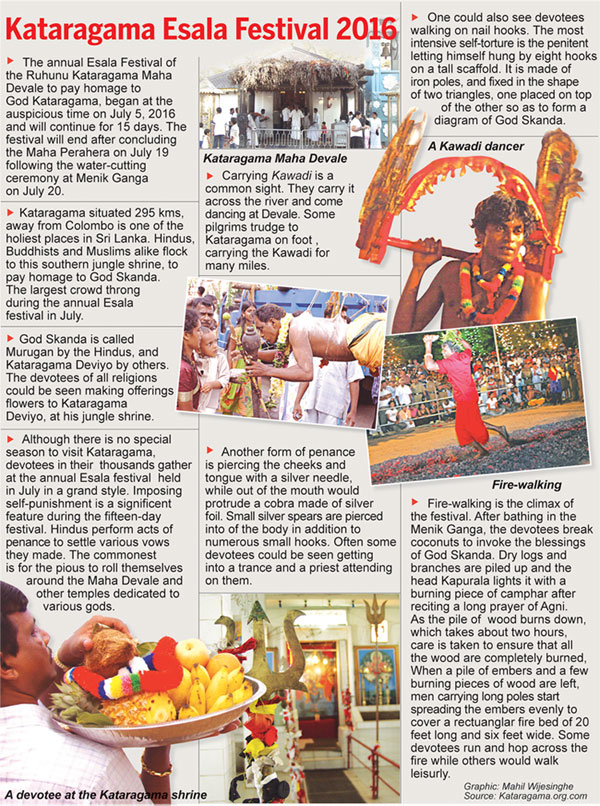|
God Skanda’s Kataragama:
Land of unity and divinity
 Kataragama in the deep South is a holy land, renowned as the abode of God Skanda.
Both Buddhists and Hindu flock to venerate the various places of worship in the
holy city, mainly the Kiri Vehera and the Kataragama Devalaya. It is also one of
the solosmasthana – sixteen sacred sites in the island blessed by the presence
of the Buddha himself that every Buddhist should aspire to visit in his or her
lifetime. Kataragama in the deep South is a holy land, renowned as the abode of God Skanda.
Both Buddhists and Hindu flock to venerate the various places of worship in the
holy city, mainly the Kiri Vehera and the Kataragama Devalaya. It is also one of
the solosmasthana – sixteen sacred sites in the island blessed by the presence
of the Buddha himself that every Buddhist should aspire to visit in his or her
lifetime.
Kataragama is also the host city of one of the most elegant historical cultural
pageants in Sri Lanka, the annual Kataragama Esala festival which is considered
second only to the Sri Dalada Perehera in Kandy.
The perahera procession with the Basnayake Nilame, temple officials, elephants,
drummers and dancers wends its way to the temples within the complex and then to
the Valli Amma temple, before returning to the Maha Devalaya. “Walking on fire”
is another highlight of the Kataragama Esala festival.
Flocked
A large number of devotees from all areas of the country including the North and
East have already flocked to Kataragama ahead of the Esala Full Moon Poya day
which falls on Tuesday. Devotees from the North and the East reach Kataragama
through a Pada Yatra (foot pilgrimage) ritual.
Kanda Surindu, as the Kataragama deity is known in somewhat formal Sinhala, is
epitomized by the Sinhala verse ‘Muhunu sayaki – ath dolasaki – Mayura pita
vāhane’ which essentially describes him as having six faces and twelve hands,
mounted atop his vehicle – the peacock.
He is regarded by the Buddhists as one of the four guardian deities of this
land. The entire south is in fact known as ‘Deiyange Rata’ (God’s Country). The
Hindus know him by many names - as Skanda - the God of War, Lord Murugan,
Kadirkamam, Subramanya, or Kandasamy.
 The Kataragama Esala festival draws in large crowds of people year after year to
pay homage to God Skanda. Even during the height of the conflict, this was a sea
of harmony that saw the intermingling of all communities and faiths. Perhaps
only Sri Pada (Adam’s Peak) can surpass Kataragama in this regard. The Kataragama Esala festival draws in large crowds of people year after year to
pay homage to God Skanda. Even during the height of the conflict, this was a sea
of harmony that saw the intermingling of all communities and faiths. Perhaps
only Sri Pada (Adam’s Peak) can surpass Kataragama in this regard.
How God Skanda left the sacred mountain of Kailasa in the Himalayas to make his
home in the forests of Lanka for the love of a beautiful maiden named Valli-amma
who had been raised by the Veddahs is a story we have all heard. Legend has it
that in the quest for an all-defining victory in the battle against King Elara
and the Chola troops, King Dutugemunu was believed to have had an encounter with
Lord Kataragama (Skanda Murugan).
King Dutugemunu asked for strength to overpower his enemies. With his wish
granted, the Kataragama Devalaya was subsequently built in fulfillment of the
vow. (Hence the practice of vows at Kataragama). The King had asked what should
be done as a means of fulfilling the vow and Lord Kataragama replied by striking
an arrow in the direction of Wedahitikanda from Kiri Vehera, and requested a
temple be made at the point where the arrow had struck.
Kataragama was also considered the home of the warrior clan, the Kshatriyas who
were invited to Anuradhapura by King Devanampiyatissa (3rd Century BC) for the
planting of the sacred sapling Bo tree under which the Buddha reached
Enlightenment. In turn, King Devanampiyatissa decreed that one of the first
eight saplings (Ashtaphala Bodhi) of the sacred Bo tree in Anuradhapura be
planted in Kataragama.
  In the days gone by, even for those did not take part in the Pada Yatra, the
trip to Kataragama was a tedious one. Today, it is still a long journey but a
less tedious one. With an expressway and railway track coming up, Kataragama
will be much closer to the rest of the country. But devotees who flock
Kataragama do not seek comfort – they come here to be blessed by the Kataragama
Deviyo. In the days gone by, even for those did not take part in the Pada Yatra, the
trip to Kataragama was a tedious one. Today, it is still a long journey but a
less tedious one. With an expressway and railway track coming up, Kataragama
will be much closer to the rest of the country. But devotees who flock
Kataragama do not seek comfort – they come here to be blessed by the Kataragama
Deviyo.
Most people go to Kataragama first when they buy a new vehicle to seek
His blessings. There are numerous other occasions which warrant a visit to the
domain of God Skanda.
Quadrangular
Menik Ganga separates the area of the ‘devale’ from the rest of Kataragama. The
Maha Devale, a quadrangular building is set in the middle of the large complex
where peacocks and elephants are a recurring motif adorning the outer walls.
Pilgrims follow the age-old tradition of having a bath in the river and
cleansing before proceeding to the ‘devale’. They also wear clean clothes,
mostly white. Most pilgrims buy a basket of fruits and a garland of flowers for
the ‘deviyo’. Crowds converge at the shrine room hours ahead of the ‘pooja’.
A curtain covers the area where the rituals are done by the ‘kapurala’ after
accepting the pilgrims’ offerings. (Next to the main shrine are the shrines
dedicated to God Vishnu and God Ganesha). After a while the fruit baskets are
returned with part of the offerings which are consumed by the pilgrims. This is
a scene of intense devotion, with the pilgrims standing together as one
enthralled by the majestic aura of God Skanda.
 |

